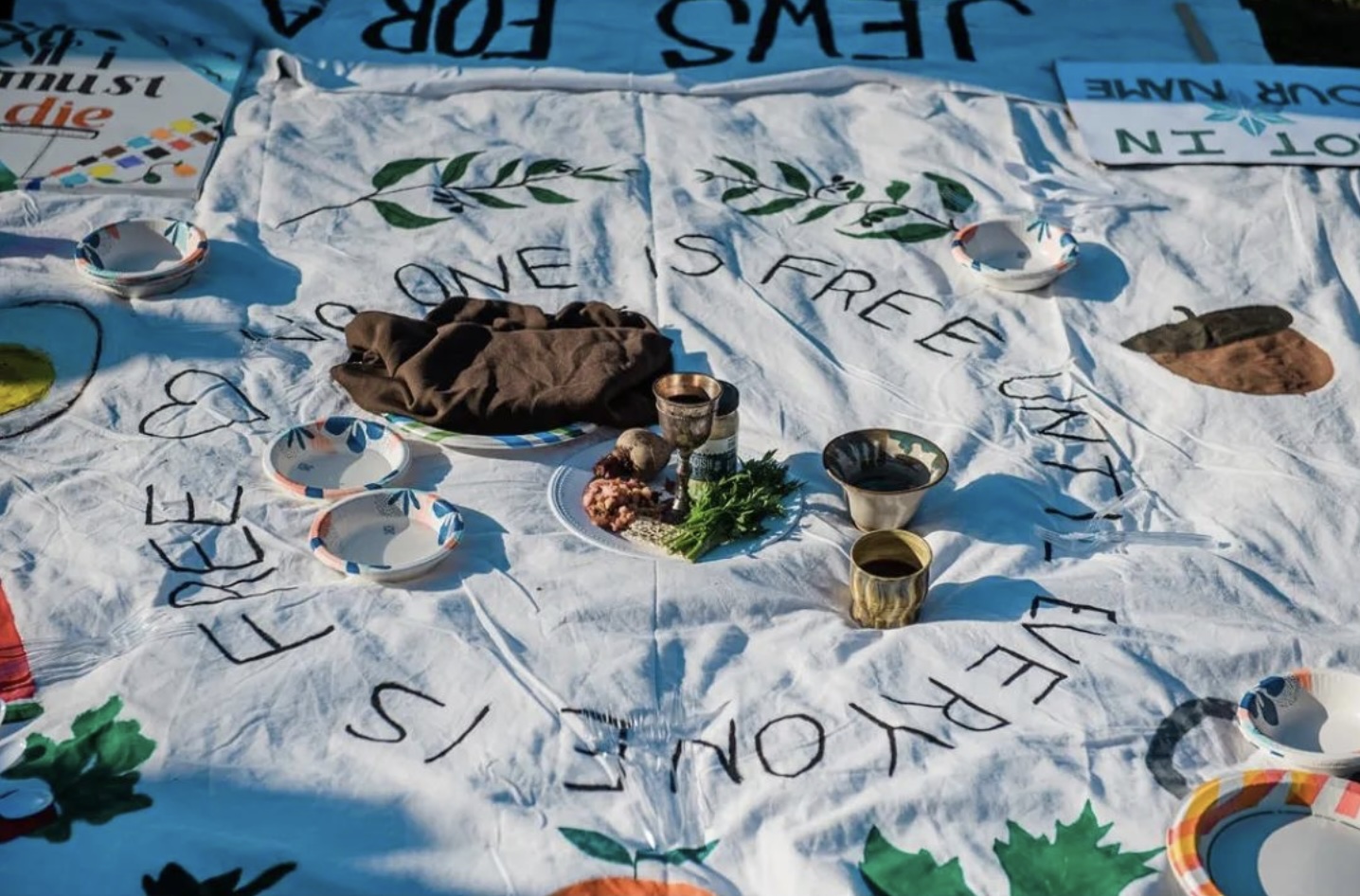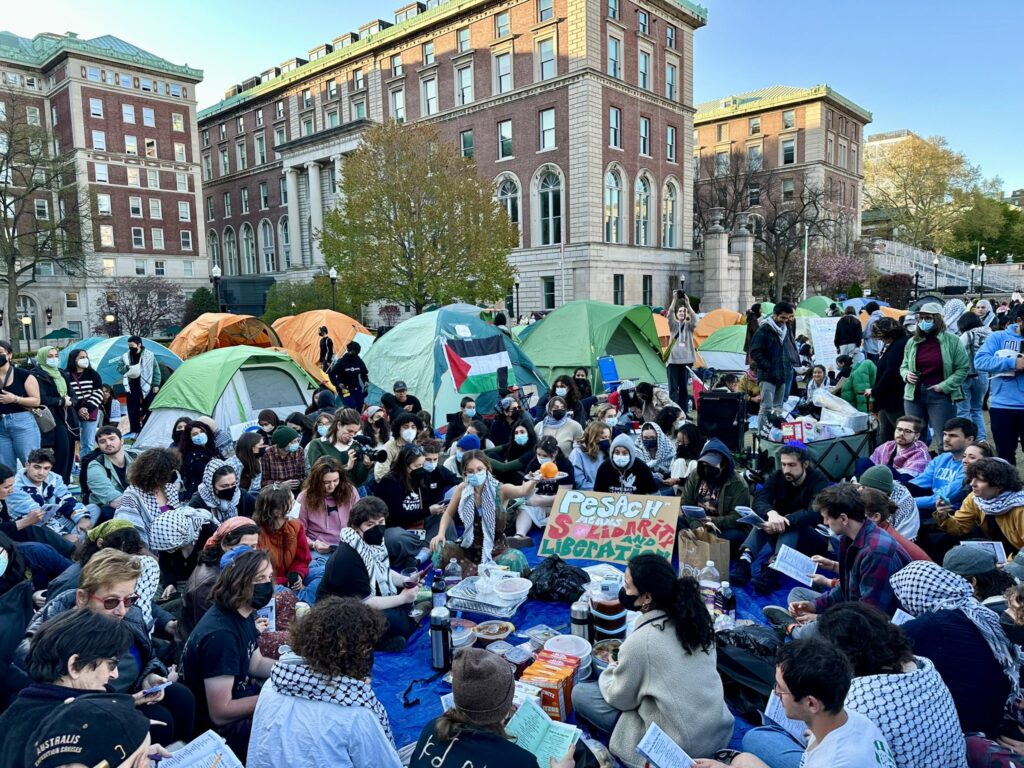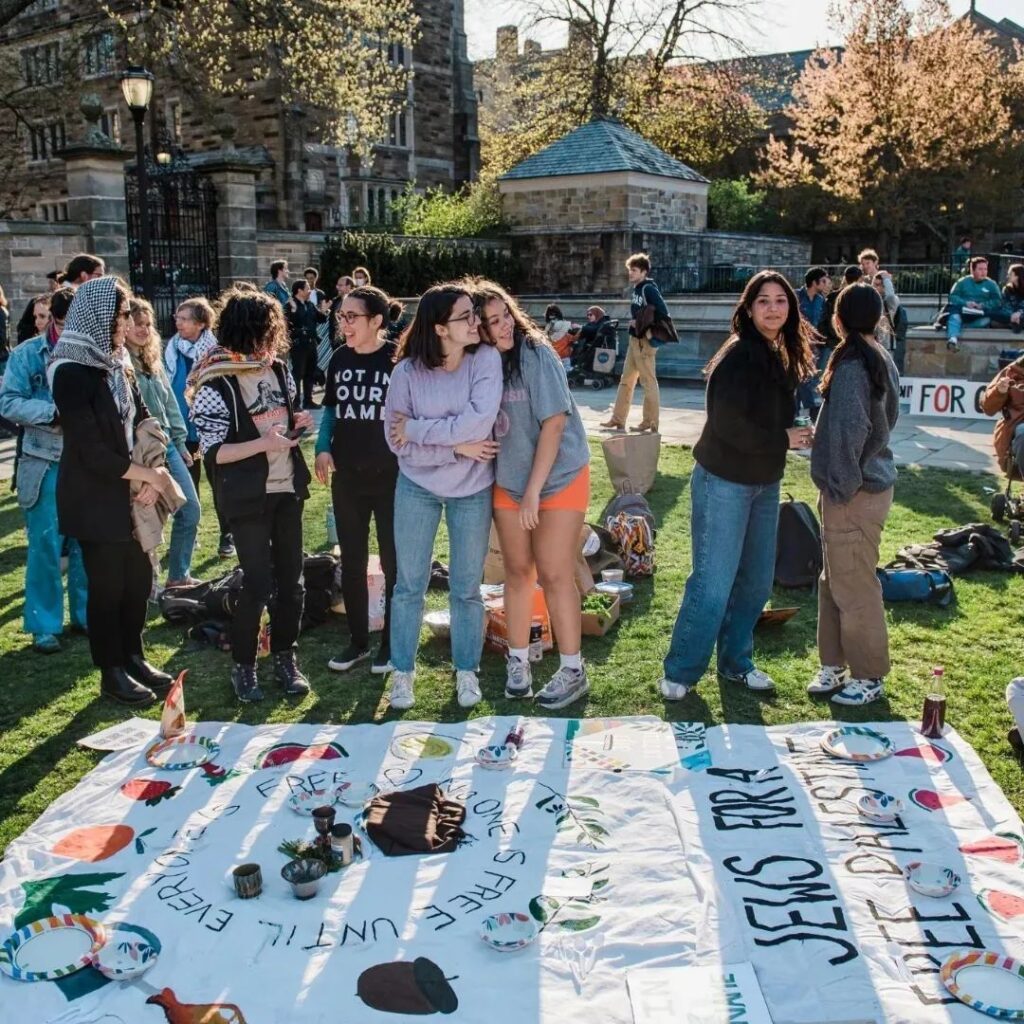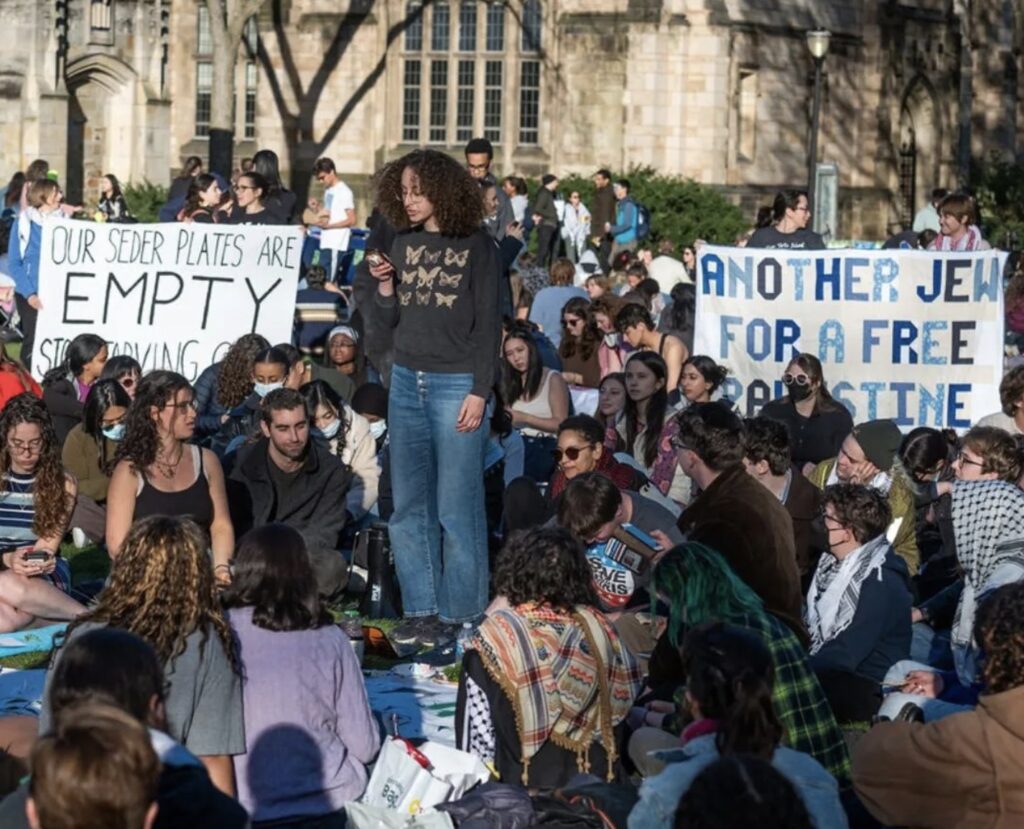The truth about campuses.

Students at Yale gather for a Passover Seder calling on the Yale Corporation to divest from weapons manufacturers. Photo courtesy of Joel Callaway.
In April and May 2024, thousands of students at over 150 college campuses across the United States rose up in peaceful protest to demand that their universities divest from apartheid and genocide.
Students pitched tents on their university laws, reclaiming the space as “liberated zones” and “popular universities for Gaza.” Inside these encampments, students held Shabbat services and Jummah prayers, led Passover seders and seminars about Palestinian history, colonialism, and antisemitism, ate meals together, shared literature, and made art and music.

Students at the Columbia University encampment hold a Passover Seder (Photo: Simone Zimmerman)
Pro-genocide politicians were determined to tell a different story. They smeared these peaceful, anti-war student protesters, many of whom were Jewish, as violent, antisemitic mobs. Much of the mainstream media has been happy to amplify these slanders.
In truth, the vast majority of student encampments were peaceful. But that didn’t stop university administrators from deploying militarized police to terrorize and brutalize their students and faculty. Police crackdowns on campus protests resulted in thousands of arrests — part of what Palestine Legal calls an “unprecedented, McCarthyite campaign of anti-Palestinian repression” across the United States since the Gaza genocide began.
What were (and are) students demanding?
Student demands centered on divestment. They called for their university administrations to cut ties with weapons manufacturers, defense contractors, tech companies, and other institutions that profit from Israeli apartheid and occupation, and most recently, Israel’s genocide of Palestinians in Gaza.
Students also expanded their demands to reflect local contexts. At Columbia, students called on their university to “disclose and sever all ties” with the NYPD, and at the University of Chicago, students demanded divestment from construction projects that continue to displace local communities in Chicago’s South Side.
What was it like to be Jewish inside the encampments?
Together, these students forged a sense of community that transcended religious and cultural divides, one rooted in an unshakable belief in collective liberation — that none of us are free until all of us are free.
Jewish students played a critical role in this movement, from coast to coast.
Jewish ritual and practice was a sacred and sustaining part of the encampment space for Jewish students from coast to coast. During Shabbat services, students sang “ceasefire now” and recited the Mourner’s Kaddish for the members of their community whose families were killed in Gaza. On some campuses, students incorporated netilat yadayim, or the practice of washing your hands before prayer, to draw attention to the way access to clean water has been turned into a weapon of war against Palestinians.
“We talked about Palestinian steadfastness, or sumud, and how that inspires us in relation to Shabbos — thinking of it as a way of resting in order to sustain our energy, to then come back and keep working and keep fighting.”
– Katja Stroke-Adolph, University of Chicago
“For me, the encampments offered opportunities for Jewish learning and community building. We organized a Passover Seder and observed Shabbat and Havdalah, and we were part of a multicultural, interfaith space – a glimpse of the world we hope to build.”
– Benjamin Kersten, UCLA


Students at Yale gather for a Passover Seder calling on the Yale Corporation to divest from weapons manufacturers. Photos courtesy of Joel Callaway.
“As I lay out under the stars on a tarp, I am overcome with an overwhelming amount of pride. Proud to be a Jew, who was taught the importance of tikkun olam, to heal the world. Proud to be queer, to understand the necessity of extending empathy to others and standing in solidarity with all marginalized people. Proud to be in a community of students unafraid to stand up and peacefully protest for change.”
–Adrien Braun, Trinity College
“The most pro-Jewish thing you can do is be anti-genocide, no matter who that genocide is being done against … When I learned about the Holocaust and I said never again, I meant never again for anyone and I will stand by that.”
– Robin Buchanan, University of Colorado Denver
As organizers of the Freedom Seder did in 1969, many Jewish students inside the encampments applied the liberation story at the heart of Passover to the desperate political conditions of the moment.
On the first night of Passover, Jewish students from Columbia University and Barnard College led a “Gaza liberation seder” inside their encampment. Some participants wore kippot made to look like watermelon, which symbolizes the Palestinians flag, while others donned Keffiyehs. Alongside the traditional items on the seder plate, watermelon was also included. As Jewish students led around 100 of their peers in song and prayer, they spoke of the Palestinian struggle for liberation.
At encampments across the country, Jewish students led similar Passover seders. At Yale, hundreds attended a seder organized by the Yale group Jews for Ceasefire and the New Haven Chapter of Jewish Voice for Peace. As protesters gathered around a sheet painted to look like a seder table, they spoke of Palestinians’ suffering in Gaza. Others held banners that read: “Our Seder plates are empty, stop starving Gaza” and “Another Jew for a free Palestine.”
Violence from whom?
Student protests were peaceful. It is clear that the police and right-wing agitators were responsible for the violence that occurred on campuses across the country.
Police were called in by numerous university administrators to crush student protesters. Clad in riot gear, they swarmed college campuses to dismantle encampments by force, arresting thousands of students, faculty, and peaceful activists. Cops used tear gas and stun guns, beat and threw professors and students to the ground, and shot them with rubber bullets. One video shows a protester at Emory University being held to the ground by several cops as they press a taser to his body.
At UCLA, masked vigilantes — many of whom had no connection to UCLA — violently attacked student protesters with wooden planks, poles, and mace, and attempted to destroy their encampment. More than 150 students were assaulted with “pepper spray and bear mace,” and at least 25 had to be transported to the emergency room “for injuries including fractures, severe lacerations and chemical-induced injuries.”
Yet it is the peaceful student protesters, many of whom are Jewish, who continue to be smeared as violent, antisemitic mobs and “outside agitators.” This trope has been regularly trotted out to discredit civil disobedience protests for over 50 years. It represents a transparent attempt to excuse the brutal crackdown being carried out against peaceful student protesters, and justify further attacks on constitutionally protected freedoms.
Many of the student encampments have since been dismantled, but protesters remain steadfast. Hundreds of students walked out of their graduation ceremonies to protest their universities’ complicity in genocide. Even when Columbia administrators canceled commencement, protesters weren’t deterred: They simply held their own ceremony: “The People’s Graduation.”
In the last days of May, as alum returned to campus for a reunion weekend, student protesters at Columbia University reestablished their encampment — the third since mid-April. These students have seen a glimpse of the kind of future all of us want, and they’re not going to stop fighting until it’s a reality.
“‘Existence is resistance,’ is a popular refrain in the Palestine liberation movement. At the Popular University, I learned that recognition is solidarity. In sharp contrast to the administration’s stance, students had built a minisociety on the premise of recognizing Palestinian life, and the impact of that work was enormous,” writes University of Chicago’s Eman Abdelhadi.
“In bringing our worlds together, the UChicago Popular University for Gaza…helped heal some of the wounds of the past seven months and reenergized us for the fight ahead.”
Explore Resources
Get The Wire
With nearly 100,000 subscribers, the Wire is one of the largest American publications dedicated to justice. Every week, we cover important news from Palestine, the United States, and the Palestine solidarity movement — and provide ways to take action.